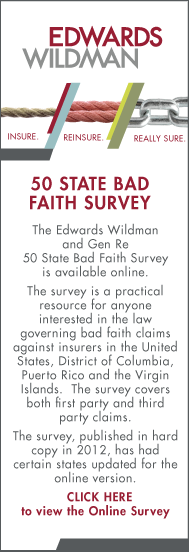 |
|||||||||||||||||||||||||||||||||||||||||||||||||||||||||||||
| edwardswildman.com | |||||||||||||||||||||||||||||||||||||||||||||||||||||||||||||
|
Concussions in Professional and Amateur Athletics: Potential Liability for Traumatic Brain Injuries Suffered During Sporting Events by John D. Hughes (Boston), Barry Leigh Weissman (Los Angeles) and Nicholas A. Secara (New York) Over the last two years, there has been a significant increase in public awareness concerning the possible long-term consequences resulting from concussions sustained during sporting activities. Barely a week passes without news of a current or former athlete who either has recently sustained a severe concussion or claims to be suffering from the latent and debilitating effects of past concussions. Although professional and collegiate football have received the most notoriety, similar, if not higher, concussion rates exist in other sports such as soccer, hockey, cheerleading and gymnastics. Insurers and reinsurers have a difficult task ahead: preparing for the defense and possible liability exposures that will follow in the wake of concussion-based litigations. In addition, carriers must determine whether the bodily injury in the form of concussions was caused by an “occurrence” sufficient to trigger coverage under general liability policies. These issues are further complicated by the inherently long-tail nature of concussion-based claims. This article examines the current legal landscape. Section I surveys the ever-growing mass of concussion litigations. Section II discusses several issues raised and defenses asserted in recent coverage disputes. Section III analyzes the “occurrence” issue as it pertains to general liability policies. Finally, Section IV provides an overview of additional coverage concerns that should be of interest to insurers and reinsurers alike. Section I – Bodily Injury Litigations Since 2011, plaintiffs have commenced several class actions seeking to recover damages for traumatic brain injuries allegedly sustained while participating in professional and amateur athletic activities. Class representatives have asserted myriad claims seeking to hold liable entities that were involved to varying degrees in the underlying sporting events. To date, defendants have included professional leagues, amateur athletic associations and sporting equipment manufacturers. It is foreseeable that future claims may arise against school districts, sporting event organizers, professional players’ unions or players’ associations, and municipal park districts. Insurers and reinsurers would be wise to consider the array of claims alleged in these litigations. In the well-publicized In re NFL Players’ Concussion Injury Litigation, E.D. Pa., No. 2:12-md-02323, putative class action plaintiffs, representing a class of former professional football players and their spouses, asserted claims against the National Football League and NFL Properties LLC (collectively, the “NFL”) for negligence, negligent misrepresentation, negligent hiring, negligent retention, fraud, wrongful death, loss of consortium, civil conspiracy/fraudulent concealment and medical monitoring. Class representatives also asserted claims against Riddell, Inc. and its related entities (collectively, the “Riddell Defendants”), which had manufactured, sold and distributed the official helmet of the NFL since 1989. Claims against the Riddell Defendants included negligence, design defect, manufacturing defect and failure to warn. Earlier this year, the NFL settled the lawsuit against it for $765 million without admitting to any fault. The claims against the Riddell Defendants, however, currently remain in mediation. Three class action lawsuits have also been filed against the National Collegiate Athletic Association (“NCAA”). In Arrington v. NCAA, N.D. Ill., No. 1:11-cv-06356, the NCAA is being sued for breach of express and implied contract, unjust enrichment, negligence, fraudulent concealment and for medical monitoring. Four collegiate athletes (two football players, a female soccer player and a men’s hockey player) are attempting to represent a putative class of all current and former NCAA student-athletes who have suffered a concussion or concussion-like symptoms during a NCAA sponsored sporting event. Durocher v. NCAA, S.D. Ind., No. 1:13-cv-01570 involves three former collegiate football players who sued the NCAA, the Riddell Defendants and Kranos Corporation, a manufacturer, seller and distributer of football equipment. Seeking to represent a putative class of all former and current NCAA football players, and their spouses, who sustained a concussion or concussion-like symptoms while playing in a NCAA football game, these class action plaintiffs asserted claims for negligence, fraudulent concealment, unjust enrichment, loss of consortium, and for medical monitoring, design defect, manufacturing defect and failure to warn. Similarly, in Walker v. NCAA, E.D. Tenn., No. 1:13-cv-00293, three former collegiate football players, who seek to represent a putative class of all former NCAA football players who allegedly suffered repeated traumatic head impacts, sued the NCAA for gross negligence, breach of contract and for medical monitoring. Section II – Coverage Disputes As discussed in Section III below, it is not necessarily clear that claims for traumatic, concussive brain injuries are covered under general liability policies. Given the uncertainty, insurers and insureds alike have brought declaratory actions seeking to define the insurers’ duties and obligations. For example, in Riddell, Inc. v. ACE American Insurance Co. , Cal. Super., County of Los Angeles, No. BC482698, Riddell, Inc. and its related entities (collectively, the “Riddell Plaintiffs”) argued that the losses they had incurred and/or continue to incur in defending against seven underlying actions premised on concussion injuries potentially fall within the scope of several primary and excess policies that provide commercial general liability and products liability coverage. According to the Riddell Plaintiffs, three insurers agreed to defend, while one insurer agreed to defend upon exhaustion of its self-insured retention and subject to a reservation of rights. The remaining insurers refused to defend, and none of the insurers agreed to indemnify. The Riddell Plaintiffs, consequently, brought an action for declaratory relief as to the duty to defend and indemnify, for breach of contract and for breach of the implied covenant of good faith and fair dealing. Insurers have advanced several coverage defenses when responding to concussion-based coverage requests that are potentially outside the scope of the relevant policies. TIG Insurance Co. v. NCAA, D. Kan., No. 2:12-cv-02361, involved a declaratory judgment action that two insurers brought disputing that the commercial general liability policies they had issued to the NCAA obligated them to defend or indemnify the NCAA with regard to Arrington v. NCAA. The insurers argued that the policies’ terms, conditions, provisions and exclusions—specifically an “Athletic Participants Exclusion”—obviated coverage. The insurers also denied coverage, in part, to the extent that the alleged injuries:
Section III – The “Occurrence” Issue If a comprehensive general liability policy provides coverage for the “bodily injury” caused by a concussion, the question will be: “when was that bodily injury caused by the concussion?” This question is relevant because only when there is bodily injury caused by an “occurrence” is coverage triggered under a CGL policy. See, e.g., A.W. Chesterson Co. v. Massachusetts Insurers Insolvency Fund, 445 Mass. 502, 520, 838 N.E.2d 1237, 1251, n. 10 (Mass. 2005). Courts will look to medical science for the answer on whether the bodily injury caused by a concussion happens at a single point in time or whether it can happen over a successive period of policy years. Generally, coverage for bodily injury is triggered when such injury is sustained, which may be before such injury is either discovered or manifested. See Trustees of Tufts Univ. v. Commercial Union Ins. Co. , 415 Mass. 844, 853-54, 616 N.E.2d 68, 74-75 (Mass. 1993). Furthermore, when bodily injury is sustained over multiple policy years, every general liability policy in effect during those years will have its coverage triggered. See Olin Corp. v. Certain Underwriters at Lloyd’s London, 468 F.3d 120, 126-27 (2d Cir. 2006). Even if the answer is that the bodily injury occurs over multiple policy years, there can still be only one “occurrence,” thereby triggering only one policy year if the CGL policy in effect at that time contains specific “grouping language.” See, e.g., Appalachian Ins. Co. v. General Electric Co., 8 N.Y.3d 162, 863 N.E.2d 994 (N.Y. 2007); Mt. McKinley Ins. Co. v. Corning Inc., 28 Misc. 3d 893, 903 N.Y.S.2d 709 (N.Y. Sup. Ct. 2010); ExxonMobil Corp. v. Certain Underwriters at Lloyd’s, London, 15 Misc. 3d 1144(A), 841 N.Y.S.2d 819 (N.Y. Sup. Ct. 2007), aff’d 50 A.D.3d 434, 855 N.Y.S.2d 484 (1st Dept. 2008); Bausch & Lomb Inc. v. Lexington Ins. Co., 414 Fed. App’x 366, 368 (2d Cir. 2011) (“contracting parties may define ‘occurrence’ in a manner that groups ‘certain types of similar claims’”). General liability policies define an “occurrence” generally as “an accident, including continuous or repeated exposure to substantially the same general harmful conditions.” See Bausch & Lomb, 414 Fed. App’x at 368. However, generally the phrase “continuous or repeated exposure” to conditions does not constitute specific aggregation language sufficient to group together numerous bodily injury claims. See Appalachian, 8 N.Y.3d at 172-73; see also Mt. McKinley, 903 N.Y.S.2d at 716 (“policies defining occurrence as ‘an accident, event, happening or continuous or repeated exposure to conditions . . .’ or to that effect do not contain grouping language”) (asbestos bodily injury claims). An example of policy language that is designed effectively to group numerous instances of bodily injury into a single occurrence would be a “lot” or “batch” clause relevant to product liability claims. Such a clause can be found in London Market Insurers v. Superior Court, 146 Cal. App. 4th 648, 659, 53 Cal. Rptr. 3d 154, 162 (Cal. Ct. App. 2007): “All . . . damages arising out of one lot of goods or products prepared or acquired by the Named Insured . . . shall be considered as arising out of one occurrence.” In the absence of specific policy language grouping numerous instances of bodily injury into a single occurrence, there are two principal tests that the courts follow to decide whether more than one instance of bodily injury will be treated as one or more occurrences. The first test is the Sole Proximate Cause Test, which focuses on whether the injuries or losses can be traced to a single originating cause. See Appalachian, 8 N.Y.3d at 170. Under the Sole Proximate Cause Test, the issue is whether there has been one proximate, uninterrupted and continuing cause that resulted in all of the instances of bodily injury. The second principal test is the Unfortunate Events Test. This test does not look solely at the cause of the bodily injury, but rather on the nature of the incident giving rise to the insured’s liability. See Bausch & Lomb, 414 Fed. App’x at 369 (“Under the unfortunate events test, the incident giving rise to liability is exposure to the defective product, not the manufacture or sale of the product. To determine if multiple incidents arise from a single occurrence or multiple occurrences, the unfortunate events test analyzes ‘whether there is a close temporal and spatial relationship between’ or ‘the same causal continuum’ for the incidents giving rise to the injuries.”). In applying the Unfortunate Events Test, courts consider these issues:
Under the Unfortunate Events Test, a “common cause” may not satisfy the temporal/spatial nexus and/or causal continuum requirement. Under the Sole Proximate Cause Test, in contrast, courts trace all bodily injuries back to a single, negligent act and deem the “accident” to have “occurred” then. Section IV – Additional Coverage Concerns This section provides an overview of coverage issues that have not been discussed in other portions of this article, but which may be key in a given case. First, in claims concerning organized athletic activity, it is anticipated that the “Expected or intended injury” exclusion would be invoked by the carriers. The standard form general liability policy states that the insurance does not apply to “bodily injury . . . expected or intended from the standpoint of the insured.” This exclusion could apply, based on the premise that individuals who engage in sports such as football and soccer know or should know that there is a substantial probability that they will suffer some sort of physical injury, including a concussion. Related to the “Expected or intended injury” exclusion is the defense under the common law for “known loss” or “known risk.” Head injuries are a known and expected consequence of contact sports like football and soccer. While expected players are not to have read the scientific studies linking head trauma to degenerative brain disorders in athletes, one would expect them to have been aware of the studies and the potential for injury. General liability policies issued to professional sports teams and leagues, as well as colleges and universities, contain provisions that exclude coverage for certain injuries sustained by participants in sporting events or in athletic contests. Courts have long upheld as valid those exclusions from coverage as long as they are conspicuous, plain and clear. Related to the occurrence issues discussed in Section III, complex allocation issues lie ahead, as courts’ opinions vary on how to apportion a loss. These issues become increasingly complex when dealing with multiple insurers and insureds, and when claimants have suffered progressive injuries that extend across multiple policy periods. Some of the various allocation methods with which insurers are likely to deal are:
Summary Not since the explosion of claims for bodily injury caused by exposure to asbestos has the insurance industry been faced with such a myriad of complex coverage issues. As with asbestos, medical science concerning when bodily injury is caused by a concussion is in flux. Unfortunately, with this science in development, concern is heightened that courts will reach inaccurate and inconsistent decisions regarding the application of coverage principles to particular factual situations. Insurers and their reinsurers would be well advised to work together to attempt to provide a common approach. Contact
| ||||||||||||||||||||||||||||||||||||||||||||||||||||||||||||
 |
|||||||||||||||||||||||||||||||||||||||||||||||||||||||||||||




